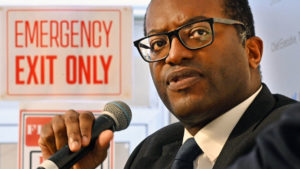Shortly before the Government’s ill-fated budget, I had coffee with a Conservative MP who was keen to stress that the Tory party was heading towards disaster. It isn’t going to work, the MP told me, likening Truss’s breakneck dash for growth to the Barber budget of 1971, which created sudden unsustainable GDP growth followed by a calamitous economic crash — “a naive, irresponsible gamble”, as Dominic Sandbrook has it, “based on rosily optimistic predictions that were never, ever vindicated”. The MP was right, up to a point: we got the bust without the intervening boom.
Instead, Truss’s dash for growth spooked the markets, which disbelieved her tax cuts could ever create enough growth to pay for her massive borrowing, and in a desperate attempt to mollify them we’ve been suddenly plunged back to the grim economics of austerity. Learning nothing from the last time, public spending will be slashed, along with investment in research and development, hobbling prospects of future growth. At this stage, and in such a deteriorating international climate, a return to stagnation would seem almost like a blessed relief. But there’s another way of looking at the problem, as the MP wondered out loud: “do normal people even care about growth anyway?”
It’s a good question. As the authors of The Future is Degrowth remind us, despite being taken for granted by economists and ordinary people alike, GDP growth as a measure of economic health is a very recent phenomenon, the product of the need to measure the success of investment and to track industrial capacity during the Second World War. As they observe: “Before 1950, there was almost no interest at all in economic growth as a policy goal in political statements or economic literature.” Rather, full employment, stability and reconstruction were the government’s priorities.
The one-off conjunction of spectacular growth rates and rising living standards following the Second World War led, they argue, to a folk association of GDP growth and personal prosperity. As they argue: “The fact that key democratic, social, and cultural rights were… fought for in the context of expansive modernity, and that within the growth paradigm societal progress became conflated with GDP growth, has laid the foundation for a powerful common sense, based on lived experience, that social improvements do indeed require economic growth and the development of the productive forces.”
It’s not an unreasonable deduction: of course, post-war “high growth rates did translate to a certain democratisation of prosperity”. Yet the relationship between GDP growth and prosperity is far from exact. Britain’s economy grew 7.5% last year as we came out of lockdown, dwarfing the post-war boom, though few would claim we’ve never had it so good as in the halcyon days of 2021. The highest ever upward GDP swing came in 1939 as Britain pivoted to a war economy, though the Second World War was hardly a golden era of mass prosperity. At the peak of Britain’s industrial, economic and political might in the 19th century, growth rates averaged 1.1% — significantly below GDP growth during the 2010s, commonly experienced as an era of stagnation and falling living standards. The unsettling prospect of an imminent nuclear exchange would, after what would admittedly be a sharp fall in GDP, surely unlock a great deal of potential for long-term economic growth as the survivors rebuilt Europe’s irradiated ruins. Most people would, nevertheless, prefer it not to happen. There are, simply, many more aspects to prosperity than abstract GDP growth: the map is not the territory.
So much for the abstract: in the real world, living standards are dropping sharply, as public spending cuts have led to a collapsing health service, creaking transport infrastructure and the police’s withdrawal from their basic functions of providing law and order. The stratospheric upward rise in housing costs functions, on paper, as GDP growth, even as it erodes actual prosperity. Desperate attempts to make the line go up on the chart — whether through Thatcher’s sell-off of public assets, the shifting of industrial production to the Far East, or the conversion of Western economies to debt-fueled speculative bubbles — have all brought temporary bursts of GDP growth even as they made the economy’s fundamentals weaker and brought lower living standards in their wake. We need a different way. The problem is, no-one agrees what that way is.
It is reasonable to assume, as has now swiftly become common opinion, that just as the economic crash of the Seventies swung the pendulum of economic orthodoxy away from Keynesianism towards free-market capitalism, so is the pendulum now swinging violently back away from what it is politically useful to term “libertarianism”. But to what?
The Labour Party, after some prevarication, seems to have settled on a modest version of the Green New Deal, an attempt to revive economic growth through massive investment in sustainable technologies. In doing so, it has emulated Biden’s Green Neo-Keynesianism, emphasising that once again, where American politics leads, economic orthodoxy eventually follows. Whether or not such a course of action will save the planet — and the reality is that there is no obvious replacement for fossil fuels without massive expansion of nuclear energy — the Green New Deal can be understood as an attempt to restart the stuttering engine of GDP growth through a second industrial revolution, this time undoing the unintended consequences of the first.
Will it work? Whether or not the markets will look as favourably on a Starmer government’s push for green industrial investment as it does those of America remains to be seen. There is a great danger that Truss’s botched push for growth has queered the pitch for any future radical attempt to escape stagnation. But then, if we disentangle the quest for prosperity from that for GDP growth, the answer is that it almost doesn’t matter.
If the country has a reliable energy supply, has the industrial capacity to sustain the levels of technological sophistication to which we are accustomed, and can provide secure food and housing to its population, the hard years we are entering may still be experienced as an era of basic comfort. As a number of economists have declared, the age of growth may, in any case, have already gone for good, with all the advanced economies following Japan into a long cycle of secular stagnation, at best a broadly comfortable steady state economy with no dramatic peaks or troughs. As the “post-growth” economist Tim Jackson observes: “Low (and declining) rates of economic growth may well be the ‘new normal’.”
Such a vision accords with the vision of the sociologist Michael Mann, who, in the 2013 book Does Capitalism Have a Future?, breaks sharply with the predictions of his co-authors that global capitalism will collapse some time between 2030 and 2050. Instead, he argues: “Why should a growth rate of 1% be a capitalist crisis? Why cannot capitalism continue as a low-growth global system, which it was for much of its history? The 20th century — more precisely, the period 1945 to 1970 in the West and the end of the 20th century in the East — would then be seen as exceptional.” Even China’s spectacular growth rate “might be reduced down to the 1% level of the historic British success story” so that “all of humanity might live in an almost steady-state economy”. The future of capitalism, he suggests, “might not be tumultuous, but boring”.
But in the current international climate, steady and boring would look like an almost unattainable win. In general terms, despite every desperate attempt for a quick fix, the global economy has never recovered the sustained growth rates of the post-war era, and probably never will. Battered by the Seventies’ oil crisis, the global financial crash of 2008, the response to Covid and now by the war in Ukraine, the world economy still has the effects of the looming conflict between the US and China to prepare for, along with the increasingly tangible consequences of climate change.
It is just as possible, indeed probably more likely, that we have entered an age of growing, compound crisis. Almost a decade ago, the authors of Does Capitalism Have a Future? warned that “something big looms on the horizon: a structural crisis much bigger than the recent Great Recession”. As we await the blackouts and disorder of the coming winter, and try not to think about the prospects of nuclear war, it would be reasonable to act on the assumption this crisis has already begun.
In these bleak circumstances, a focus on shoring up near-term national resilience ought to take precedence over the prioritising of long-term growth. When the confrontation between the United States and China begins — and the US government is now briefing that the invasion of Taiwan can be expected sooner than we thought — none of the current market orthodoxies will still apply. Whatever economic plans are laid now, no matter how palatable they are to the markets, will not survive.
In planning his invasion of Ukraine, Putin evidently priced in Western sanctions and Russia’s ejection from the international banking sector, gambling that its vast mineral resources and energy resources would count for more in the world today than the economic commonsense of yesterday. As winter approaches, it is not yet clear that Putin has lost this bet: like the First World War, the conflict in Ukraine makes no conventional economic sense, but has created its own new reality. Similarly, to win a protracted Pacific war against the greatest industrial power in human history, the United States would have to reorient its entire economy around the war effort. The panicked reactions of the market to Truss’s mini-budget no more reflect the approaching colossal reordering of the global economy than Westminster lobby gossip and Downing Street psychodrama reflect the great geopolitical trends already reshaping the world around us.
At times like this, it’s hard not to feel nostalgic for the End of History. Like youth, it will not come again. It would have been far better if the decades of bad decisions that brought us here had not been made. But they were, and now we must suffer the consequences as best we can. Even the years of austerity following the 2008 crash now seem a lost hinterland of wasted opportunity: we could have invested in state capacity to see us through the hard years we have now entered. We could have expanded gas storage facilities, instead of shutting them down. We could have built nuclear power plants, high-speed rail, and all the infrastructure on which modern life in a developed nation depends, at a time when borrowing costs were practically non-existent.
Instead, we feel the absence of investment just when we need state capacity the most, and are least able to afford it. Like the grasshopper in Aesop’s fable, we frittered away the summer without providing for the winter to come, and now we shudder as the first cold winds begin to whip around us. But at least the line on the chart went up, a little, as the government of the day reassured the markets.
Just as we now perceive that we should have used better times to prepare for today, so it will swiftly become clear that we should be using the time we have now to prepare for the worse ones fast approaching. What we perceive as crisis is still a period of relative normality. At a time when the international situation is as menacing as it is, it would be comforting to have, at the barest minimum, a functioning government. Instead, we have Liz Truss, sitting on the front bench staring blankly into space as her party and country crumble around her.
Is she in charge? Is anyone? It ought to be impossible for Truss to blame the deteriorating international situation for her political woes without also proposing some measures to mitigate Britain’s exposure to the global crisis. But instead she broke her premiership and the country’s government chasing GDP growth it may never have been in her power to attain.
When Starmer wins the next election, he will be required to spend vast sums of money in rebuilding Britain’s decayed infrastructure, fixing the roof while the rains lash down. Given the international situation, Labour is correct in framing its proposed investment in infrastructure as much as a question of national security as a path to economic growth. Debt will grow, and it will have to: survival comes first, and abstract economic growth must be subordinated to this very basic goal. When even Europe’s economic giant, Germany, is trying to stave off industrial collapse, the idea that growth can be attained in the current circumstances seems entirely divorced from reality.
As eminent American economists now emphasise, near-wartime situations such as ours are not won with peacetime economies: the old rules do not apply. In any case, the feeble growth we experienced in recent years accumulated at the top, without bringing mass prosperity: voters are unlikely to punish a government that offers them higher living standards through redistribution, even without GDP growth. In the absence of growth, Labour must provide the basics of common comfort: if people can still eat, heat their homes and shelter themselves from the weather, they will count themselves prosperous, even if the GDP charts say otherwise.
Disclaimer
Some of the posts we share are controversial and we do not necessarily agree with them in the whole extend. Sometimes we agree with the content or part of it but we do not agree with the narration or language. Nevertheless we find them somehow interesting, valuable and/or informative or we share them, because we strongly believe in freedom of speech, free press and journalism. We strongly encourage you to have a critical approach to all the content, do your own research and analysis to build your own opinion.
We would be glad to have your feedback.
Source: UnHerd Read the original article here: https://unherd.com/






